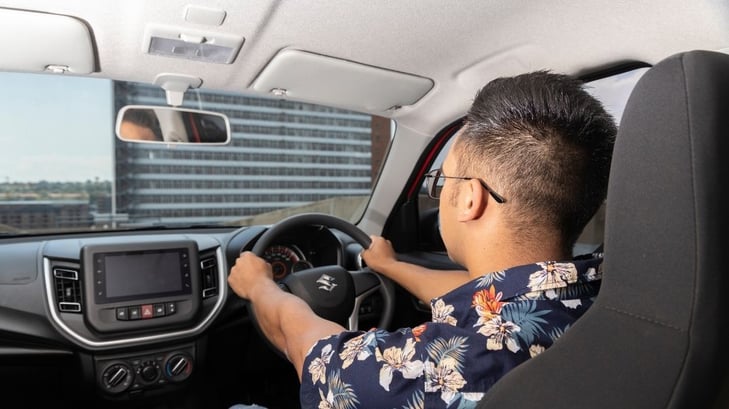 Collision avoidance systems are becoming increasingly common in vehicles these days and in today’s episode of How Things Work, different collision avoidance systems will be discussed.
Collision avoidance systems are becoming increasingly common in vehicles these days and in today’s episode of How Things Work, different collision avoidance systems will be discussed.
If you can’t watch the video, you can read the video transcription below:
Edited for clarity and readability
Welcome to Let's Talk Automotive. And in this week's segment on How Things Work, we're going to be taking you through the basic workings of collision avoidance systems that we're starting to see more and more on our vehicles these days. So the first one I'm going to start off with is our forward-facing collision avoidance systems. So in basic terms, the way this works is that we either have a radar system that's pointing forward that's detecting any objects, including vehicles in front of us, and indeed we can even have lasers or a combination of the two. But in essence, what the forward-facing collision avoidance system is doing is calculating constantly our potential time to impact between ourselves and the vehicle that's in front of us. And as soon as the control unit feels that we are getting too close to a vehicle and that we might impact, the car itself will autonomously brake for us and hopefully, prevent a collision.
Now, obviously, we can't defy the laws of physics. And if our closing-in rate is too great, we can still have an accident, but at least we would have slowed down the vehicle considerably by the time we impact the vehicle in front of us. And in fact, engineers call the forward-facing collision avoidance systems an electronic crumple zone.
Now, there were a few challenges prior to these systems being implemented across the world. And in some countries, they were in fact banned. And the reason why they were banned is that the authorities felt that perhaps, it was an unfair advantage that one vehicle was going to be able to slow down autonomously but what about the vehicles behind? And in fact, some of the manufacturers designed systems that were rearward facing collision avoidance systems so that the vehicle could now calculate how slow it had to go in order to avoid an impact in front, but not brake too hard in order to cause a vehicle following, from impacting.
Now, one of the key systems that we use with collision avoidance technology is brake assist and we've gone through brake assist on previous episodes, but brake assist, when it was initially launched, was capped at a maximum of 25% brake force effort. And again, it goes to legislation. However, these days our systems are able to give us brake assistance up to 100%.
The next system I want to talk about is our lane departure warning or lane departure assist function that we have on our vehicles. Now, the way this works is that we have a stereoscopic camera on the windscreen of the vehicle that's facing forward. Now stereoscopic is just a fancy word for 3D, and this camera is constantly analysing conditions in front of us. And one of the main functions is for it to read the actual painted lines on the road.
And as soon as the vehicle detects that we’re straying from our lane, it's going to intervene in one of two ways. If we've got an early warning system, it's merely going to give us an alert that we are moving out of our lane. However, if we've got an advanced system and an assist system, if we start straddling the lane, what it's going to do is one of two things. It's either going to brake out inside the wheels, which will pull the car back into the lane, or it'll intervene, if we have an electric steering assisted system, by physically turning the steering wheel. Now the only time it won't do that is if we make an intentional manoeuvre out of the lane. So, if we put our indicator on and turn out of the lane, the system is not going to either alert us or prevent us from making a manoeuvre outside the lane.
The third system that we find, generally with the packages that we have on our vehicles, is blind spot assist. Now, as the name suggests, what the system does is it compensates for our inability to see vehicles that have come into our blind spot. The way that it knows that the vehicles come into our blind spot is because there are small radar devices that are either located under our wing mirrors or indeed, in the rear bumper. And so when a vehicle comes into our blind spot, at this point if we try to make a manoeuvre across a lane and into the path of the vehicle that's in our blind spot, very much like the lane keep assist system, the vehicle will either give us a warning, if it's just an early warning system, or, if it's an assist system, it's going to actually prevent us from making that manoeuvre by either braking the inside wheels once again, or physically turning our steering wheel.
The fourth system that we're finding as part of these packages is, of course, our traffic sign recognition system. Now, once again, that hardworking stereoscopic camera that we have on our windscreen is able to read our road signs. And now what happens is if we have our adaptive cruise control activated, which has activated our radar and is now maintaining our distance between ourselves and our vehicle in front of us automatically. What happens now is that if the speed limit changes, so for example, if it reduces from 120 kilometres an hour to 100, the system will automatically slow down the vehicle and prevent us from getting any traffic fines. That's if we've got the assist system, obviously if we've just got an early warning system, it's going to give us a beep and it may illuminate an icon on the cluster for us.
So as you can see, these systems are fantastic in their functionality and they've become a lot more advanced as time has progressed. And there's no doubt in my mind that these systems are actually the precursor to full autonomous driving that hopefully we're going to see soon in our cars.
So that's it for this week's episode of How Things Work. We hope you found this little bit of information useful and look forward to seeing you next week.
To watch the full episode, visit: https://www.facebook.com/watch/LetsTalkAutomotive/
Want to know when the next episode is available? Sign up to get notifications straight into your inbox.

![How Things Work: 4x4 Systems [VIDEO]](https://blog.suzukiauto.co.za/hubfs/Untitled%20design%20(21)-2.png)
![How Things Work: ABS [VIDEO]](https://blog.suzukiauto.co.za/hubfs/Untitled%20design-3.png)
